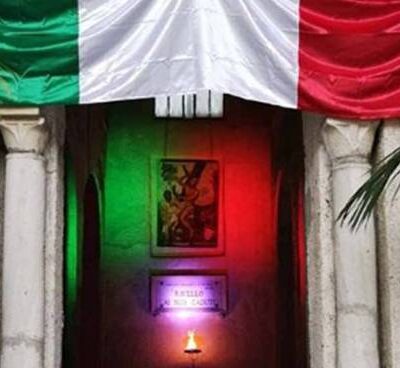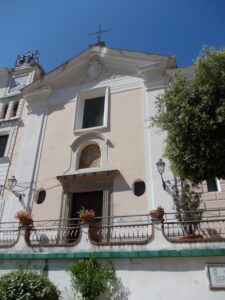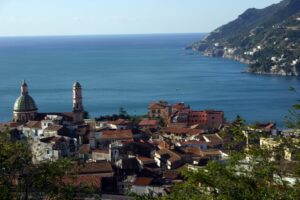MUNICIPALITY: Ravello
NAME: War Memorial (and Church of St. Augustine)
LOCATION: Piazza Fontana
DESCRIPTION:
The church of St. Augustine stands at the ancient Piazza di St. Auditore, formerly the site of the town market, stores, bakeries and taverns.
Originally the complex consisted of several places of worship, dedicated to Saints Auditore, Elia, and Pantaleon, which in 1288 were granted to the Augustinian order by the Bishop of Ravello Fra Tolomeo.
At the convent church, which in the meantime had taken the title of St. Augustine, numerous benefactors and devotees obtained burial, such as Giletta Scannapieco in the 14th century, Bonanno de Flumine in 1408 and Evangelista Bonuntuno of Ravello in 1463.
The original structure had three naves, divided by two colonnades, with three columns each. There were five altars: the high altar with a painting of the Virgin with Saints Augustine and John (to which was added, in the early eighteenth century, the image of St. Theresa, patroness of the adjoining Conservatory); The altar of the Holy Rosary, under the patronage of Francesco Manso’s family; the altar of St. Nicholas Tolentino, with a golden wooden statue, belonging to the Fusco family; the altar of Holy Mary of Constantinople, founded and governed by the administrators of Monte dei Poveri; and the last, dedicated to St. Mary of Grace, later transferred to St. Mary of Lacco in 1769.
The atrium, supported by two columns, hosted city parliaments in the centuries of the modern age and the performance of the tragedy “La Fede in Trionfo” (Faith in Triumph), written by Don Nunziante Garzillo of Solofra, which was held on the Sunday after the patronal festivity in honor of St. Pantaleon. Toward the end of the 19th century, it was in a state of total abandonment, which brought the loss of valuable works of art in painting and sculpture.
In the 1960s, through the initiative of some citizens, it was restored to public use with a radical transformation. Intended as a War Memorial, it was solemnly inaugurated on July 26, 1968 by Archbishop Cesario D’Amato.
At the present time, the church is preceded by an atrium with four columns at the corners; a round-arched entrance surrounded by two smaller columns leads into the church, which has three aisles divided by two large factory pillars. Internally, it still has some traces of a fresco on the left wall.
On February 9, 2014, the ashes of sailor Andrea Mansi of Ravello, who was slaughtered by the Germans at the entrance of the “Federico II” University of Naples on September 12, 1943, were placed at the church’s atrium.
SEE, VISIT, FIND: upon prior request to the City of Ravello.
FRUITION DATA: none





